Micro-ATX Cases - Shoebox Showdown
by Joshua Buss on January 2, 2007 12:40 PM EST- Posted in
- Cases/Cooling/PSUs
Ultra MicroFly - Interior Cont'd
Our first step with the MicroFly's install was putting the hard drive and assembled motherboard into their respective trays.
Like the other clones of this case, the MicroFly just barely works with our CNPS 7000 Cu cooler.
After making sure our CPU cooler would fit, we attached the video card with the single standard case screw and slid the completed motherboard tray into the case all the way. The largest video cards could be difficult to squeeze into the MicroFly, but it handles them better than the Aria.
The included power supply has enough wires for most anything you could fit inside the case, including two 12 volt fan headers
Our completed build from the right side. Like the other cases, there is still a little room for extra equipment in the front bottom, but unlike them there's actually a little space next to the PSU too, so with a little creativity a specialized water-cooling setup could be realized in this case as well.
The LCD display on front shows the temperatures detected by the remote sensor which we attached loosely to our Zalman CPU cooler.
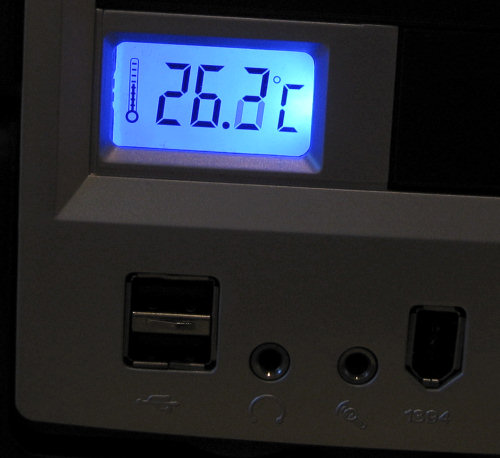
There isn't a whole lot to set the Ultra MicroFly apart from other similar micro-ATX cases, but it still represents a well-designed unit. The low cost of entry is definitely one of the most attractive aspects, and as a whole setting up and using the Ultra MicroFly was uneventful. As you'll see in a moment, the overall performance characteristics of the MicroFly are impressive, with the only potential blemish being slightly higher noise levels at full load.
Our first step with the MicroFly's install was putting the hard drive and assembled motherboard into their respective trays.
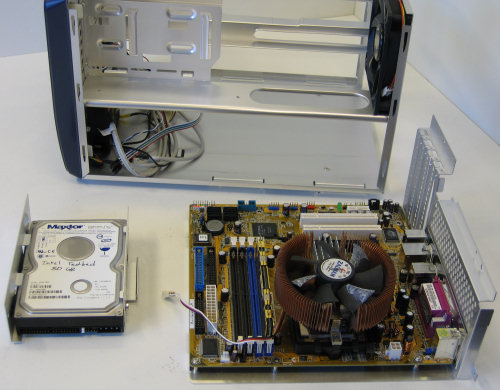 |
| Click to enlarge |
Like the other clones of this case, the MicroFly just barely works with our CNPS 7000 Cu cooler.
 |
| Click to enlarge |
After making sure our CPU cooler would fit, we attached the video card with the single standard case screw and slid the completed motherboard tray into the case all the way. The largest video cards could be difficult to squeeze into the MicroFly, but it handles them better than the Aria.
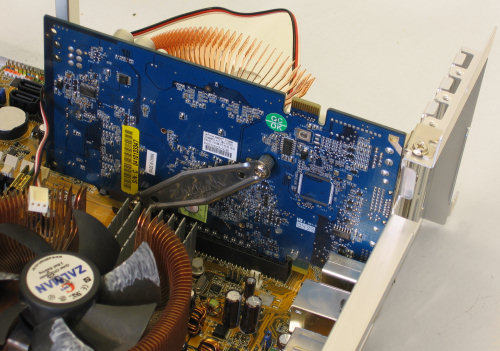 |
| Click to enlarge |
The included power supply has enough wires for most anything you could fit inside the case, including two 12 volt fan headers
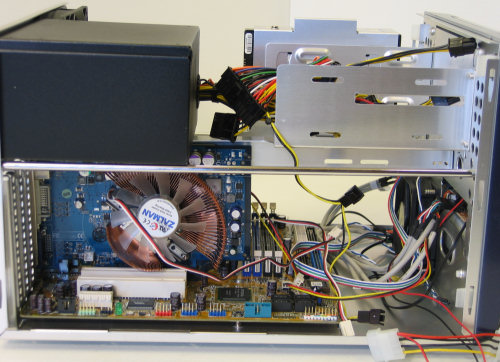 |
| Click to enlarge |
Our completed build from the right side. Like the other cases, there is still a little room for extra equipment in the front bottom, but unlike them there's actually a little space next to the PSU too, so with a little creativity a specialized water-cooling setup could be realized in this case as well.
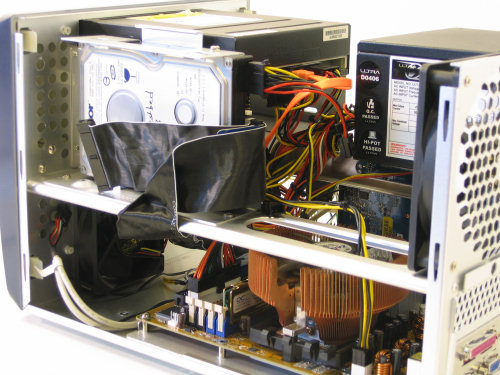 |
| Click to enlarge |
The LCD display on front shows the temperatures detected by the remote sensor which we attached loosely to our Zalman CPU cooler.

There isn't a whole lot to set the Ultra MicroFly apart from other similar micro-ATX cases, but it still represents a well-designed unit. The low cost of entry is definitely one of the most attractive aspects, and as a whole setting up and using the Ultra MicroFly was uneventful. As you'll see in a moment, the overall performance characteristics of the MicroFly are impressive, with the only potential blemish being slightly higher noise levels at full load.










37 Comments
View All Comments
warthogism - Thursday, February 1, 2007 - link
I know that you guys were able to fit an CNPS7000 in there and that a 9000 would not fit. What I was wondering is if a CNPS7700 would fit. The difference is that the height of the 7000 is 62mm and the 7700 is 67mm. Also, the 7000 has a 92mm but the 7700 uses a 120mm fan. Does anyone have first-hand knowledge? or at least, does it look like the 7700 will fit? Thanks for the help.gool - Saturday, January 13, 2007 - link
I'm the happy owner of a heavily modded Antec Aria - blow holes, sidefans, PSU-fan replacement and so on. It's based on a MSI Micro-ATX 939 motherboard, AMD 64-3200 (Clawhammer), 1 GB DDR-SDRAM, Liteon DVD-CD combo, a 160GB 7200 Maxtor disc, an external (USB2) Maxtor 250 GB disc and a Nvidia 6600GT card. The latter is the one I wish to replace, but I'm uncertain if I'm able to draw enough juice from the standard Antec 300W psu for this purpose? Seen people with a similar setup who uses a 7800GT card without problem. What are you guys advice - could I go down this road?Cheers,
Svend
Patrese - Sunday, January 7, 2007 - link
Great review, but I'd like to see something about the new (and not no new) uATX motherboards on the market, specially the Asus M2NPV-VM and Abit NF-M2 NView...artifex - Thursday, January 4, 2007 - link
I suggest everyone interested in these smaller form factors to look at sfftech.com and mini-itx.com. Plenty of reviews and some nifty case mods, etc.mino - Thursday, January 4, 2007 - link
I like that you made semi-pro noise tests for the cases.However as changing noisy PSU/fan is the easiest thing to do(I have yet to us a case with included PSU/fan)..
It would be nice to complement out-of-the-box testing with controlled-enviroment testing.
It would be more informative, especially to enthusiasts, to make a reference rig (fans, PSU, all coolers, HDD) and assemble it into different cases.
To know that a case comes with a noisy PSU is nice. However to know its ability to dampen the brum of an HDD, or mute the pinch of a GPU cooler is far better.
Nice work otherwise, keep on.
JoshuaBuss - Thursday, January 4, 2007 - link
This is a very good idea, but to a certain extent we believe it's the manufacturer's responsibility to supply a case with fans that work best for its need, not the user's. At the least a manufacturer should offer recommended buys (like PDCL did) so that a user knows what should work well. If a fans that come with a regular case are so bad that it's truly hurting the overall appeal, we normally do try it with a different configuration to see if we can do better. With these micro ATX cases it's often the case that the included power supply is a custom fit and we have to test it 'as is'.Thanks for the suggestion.
mino - Thursday, January 4, 2007 - link
I suggest you take a look at the ASUS TM-21/23/25 series especially the TM-250.I have yet to see a case of this size with better internal organization, such a good cooling performance. As a bonus the case is very sturdy (especially for such a low weight product).
The ability to put 3 HDD's in a 15.6*6.7*14inch box _and_ cool them without additional fans speaks for itself.
Newegg lists them for $50 with 300W high-quality PSU's.
However we bought 100 a month ago in EU and they came with 350W and _without_ that annoying floppy hole...
mino - Thursday, January 4, 2007 - link
One little problem I missed, those on Newegg(provided they sell the exact model as on image) have ATX 1.3 PSU's.While these Bestec PSU units are pretty good - PFC, very quiet(have 20+ of them deployed) - 180W on 12V rail may not be sufficient for a gaming rig.
I hope the new refresh models(350W,no floppy), we bought recently, will hit the US market soon.
artifex - Thursday, January 4, 2007 - link
I'd like to see a review of the power supplies used in some of these, as well as third-party replacements. Heck, I'd even like to see a new version of the old ATX PS roundup/review Anandtech did years ago -- I bought my Antec TruePower 430 after that, and it's lasted through a second system, but I've no doubt it's getting creaky now.IronChefMoto - Wednesday, January 3, 2007 - link
First off, decent article. I would like to have seen Anandtech test different video cards in the cases, though. One of the issues with nice mATX cases like the Lian Li V300 (???) is that longer, high-level chipset cards like the 7900 series hit pieces of the framework in the case. You have to mod your case or your card for the Lian Li model.While folks won't always be dropping a 7950GT into one of these, having that option is nice if you want to build a small, high-end gaming rig. Please try and make that part of your mATX review setup in the future. I've even asked Newegg.com to start adding card length data to their specs (they're opening the cards anyway for product shots) so you don't end up having to send back a card that doesn't physically fit a case by 1/4".
That said, my friend and I built v1 Aria (when it had more front ports) about 2 years ago. It was the toughest build I've ever had to do. It was cramped, the PSU had to come out for assembly, and the CPU cooler was up next to the PSU. The temps idled 60C with a very hot P4 Prescott (???) CPU. My buddy upgraded the unit with a Zalman Reserator and continues to use it today running at about 35C under load.
I would recommend that anyone looking at an mATX case check to see that the PSU is STANDARD ATX or a replaceable mATX format. The v1 Aria will not accept an ATX replacement without some modification and/or loss of space. This holds true for mATX barebones like Shuttle XPCs (I own/am stuck with two (2)).
IronChefMorimoto